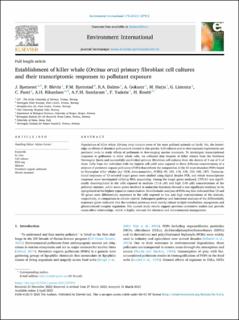| dc.description.abstract | Populations of killer whale (Orcinus orca) contain some of the most polluted animals on Earth. Yet, the knowledge on effects of chemical pollutants is limited in this species. Cell cultures and in vitro exposure experiments are pertinent tools to study effects of pollutants in free-ranging marine mammals. To investigate transcriptional responses to pollutants in killer whale cells, we collected skin biopsies of killer whales from the Northern Norwegian fjords and successfully established primary fibroblast cell cultures from the dermis of 4 out of 5 of them. Cells from the individual with the highest cell yield were exposed to three different concentrations of a mixture of persistent organic pollutants (POPs) that reflects the composition of the 10 most abundant POPs found in Norwegian killer whales (p,p’-DDE, trans-nonachlor, PCB52, 99, 101, 118, 138, 153, 180, 187). Transcriptional responses of 13 selected target genes were studied using digital droplet PCR, and whole transcriptome responses were investigated utilizing RNA sequencing. Among the target genes analysed, CYP1A1 was significantly downregulated in the cells exposed to medium (11.6 µM) and high (116 µM) concentrations of the pollutant mixture, while seven genes involved in endocrine functions showed a non-significant tendency to be upregulated at the highest exposure concentration. Bioinformatic analyses of RNA-seq data indicated that 13 and 43 genes were differentially expressed in the cells exposed to low and high concentrations of the mixture, respectively, in comparison to solvent control. Subsequent pathway and functional analyses of the differentially expressed genes indicated that the enriched pathways were mainly related to lipid metabolism, myogenesis and glucocorticoid receptor regulation. The current study results support previous correlative studies and provide cause-effect relationships, which is highly relevant for chemical and environmental management. | en_US |

